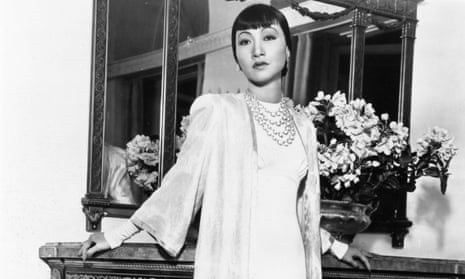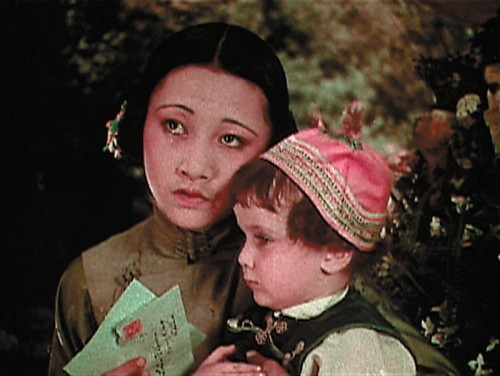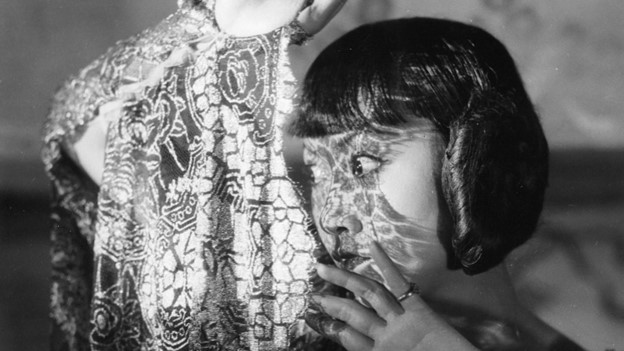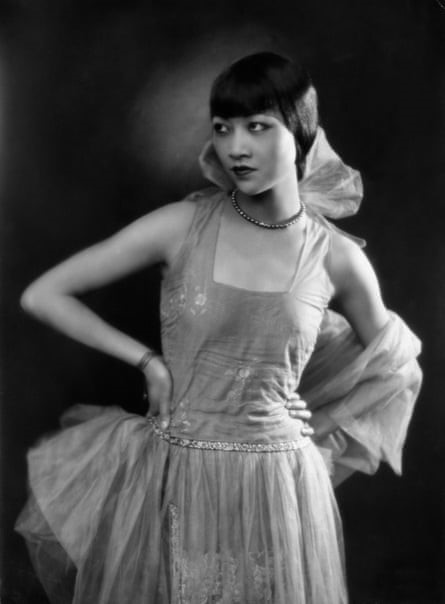Movie Star and Barrier-Breaker, Anna May Wong
Hidden Voices began as a collaboration with the Museum of the City of New York that was initiated to help City students learn about the countless individuals who are often “hidden” from traditional historical records. Each of the people highlighted in this series has made a positive impact on their communities while serving as outstanding examples of leadership, advocacy, and community service.
Today, we’re sharing the story of Anna May Wong, Hollywood’s first-ever Chinese American movie star, who captivated audiences, earned critical acclaim for her performances, and dared to break free of Hollywood’s early to mid-twentieth century typecasting practices for nonwhite actors.
"I was tired of the parts I had to play... Why should we always scheme, kill, (and) rob?"
In 1935, MGM was casting for the film, “The Good Earth,” a story adapted from a Pulitzer Prize-winning novel about a family of struggling farmers in China. The part of O-Lan, the film’s leading female role, was expected by many at the time to go to the Chinese American actress, Anna May Wong. Despite being considered the clear favorite for the role due to her popularity and her reportedly outstanding auditions, Wong would not get the part she had been desperately hoping to earn. The rules—and prejudices—of Hollywood instead dictated that O-Lan would be played by the German actress, Luise Rainer, in yellowface, or exaggerated, offensive makeup and costuming used to approximate a so-called “Asian” appearance. Instead, Wong was offered the supporting role of Lotus, which she turned down because of the part’s heavy reliance on offensive stereotypes about Chinese women.
In a cruel twist of fate for Anna May, “The Good Earth” would eventually go on to receive critical acclaim upon its release in 1937, and in 1938, Rainer won an Academy Award for her performance.
Getting passed over for the lead role in “The Good Earth” would, unfortunately, be one of the many slights Anna May faced throughout her acting career. Yet, despite the many uphill battles she faced as a nonwhite mid-20th Century actress, Wong managed to find personal success on her own terms, and is remembered today as a trailblazer, a fashion icon and Hollywood’s first-ever Chinese American movie star.

Anna May Wong was born as Huang Liu Tsong to Chinese American parents in Los Angeles, California on January 3, 1905. As the second child of eight children, Anna May grew up in a time of heightened prejudice against Asians in the United States—laws like the Chinese Exclusion Act of 1882 placed strict limits on who could or could not enter and live in the country. Despite being American citizens in their own right, Anna May and her family, like so many others like them, lived in LA’s Chinatown neighborhood out of a need for safety and community.
Her family owned a laundromat in the area, and it was there that Wong spent much of her childhood working alongside her siblings. Through this work, Anna May learned firsthand how to run a business, manage money, and—perhaps most importantly for her—work with people of all backgrounds. Even so, it didn’t take long to see that Anna May, with her rebellious spirit, had ambitions beyond the family business and instead discovered her love for movies and acting. From a young age, she regularly visited film crews working in her neighborhood, and before long, she landed her first role—as an uncredited extra in a film called “The Red Lantern”—at age 14 before she had even finished school!
Anna May’s experience in “The Red Lantern” only deepened her passion for acting, and so despite her family’s wishes for her to pursue a more financially-stable path, Anna May continued to accept more small roles following her debut. Eventually, she would land her first major part for the lead role of Lotus Flower in the film, “The Toll of the Sea (1922),” a story based on Puccini’s opera, “Madame Butterfly.” The film, shot in Technicolor, was notable not only for Anna May’s breakout role in it, but because, “Toll in the Sea” is considered to be the first-ever color feature film with a general public release. The movie launched Anna May’s budding acting career to new heights, earning her offers for roles alongside major Hollywood stars. Many of Anna May’s early roles were in movies that became major box office draws and helped to increase her fame. But despite her early successes, Wong had soon realized that common Hollywood practices for the time period would limit her true potential. As one historian describes:
“Her chances of moving up from supporting or featured player to star were improbable. Production codes against interracial kissing meant that she could not graduate to star billing… rather she had to watch as less talented white women took the roles that might have given her more fame, and, at least, more sympathetic parts.”
– Graham Russel Gao Hodges, “Anna May Wong: From Laundryman’s Daughter to Hollywood Legend“

Anna May Wong’s breakout role as Lotus Flower (left) in the 1922 silent movie, “Toll of the Sea,” gave Anna May the shot she needed to begin her movie career in earnest. (Photo is a still taken from “Toll of the Sea“)
These prohibitions were part of a set of rules in Hollywood known as the Hays Codes, which determined what—and who—would and would not be allowed to be shown on television and on movie screens. These rules forbade not just on-screen romances between white and non-white actors, but even the implications of interracial romances off-screen. And so, when Anna May’s characters were shown to be in love with white characters on-screen during her early film productions, her characters were typically forced to meet untimely ends by these movies’ final acts. Restrictions like these severely limited the types of roles that were available to her—or any other actor of color at the time.
As a result of the Hays Codes, many of the parts that Wong played relied heavily on racist and gendered stereotypes, and she regularly starred alongside actors in yellowface. In fact, because Anna May would often be one of the few people of Chinese descent working on a film production, she’d often find herself teaching some of her co-stars how to appear more “authentically Chinese” on screen—she’d offer chopstick lessons, for example, and help some of her co-stars appear “authentic” enough to play their assigned roles.
Furthermore, while the Hays Codes limited Anna May’s relationships on screen, there were also many rules governing her real life as well. One law originally passed in 1907, and which would later become part of the Cable Act of 1922, stated than an American-born woman like Anna May who married a foreign national would have to take her husband’s nationality, and she therefore would have lost her U.S. citizenship. Then, the Immigration Law of 1924 made it easier for immigrants to be expelled from the country, and even those who were legally citizens, like Anna May and her family, were at risk of being forcefully removed. In part because of laws like these, Anna May would never marry. Nonetheless, she became a staunch advocate for legalizing interracial marriages and relationships, writing once that if she were to marry, she simply wanted to “be free to love, get married, and start a new life with anyone from anywhere.”
As a result of the discrimination Wong was facing in the States, she had become fed up with Hollywood and was unfulfilled by the roles she was being permitted to play there. Seeking a change, Wong made an unusual decision for a seemingly rising star at the time: she moved to Germany. While many European actors, sensing the trend of American dominance in the entertainment industry, were leaving Europe for Hollywood, Anna May decided to do just the opposite. Even though she was only 23 years old, still early in her career, she already felt like she had few other options than to leave. In an interview in 1933, she explained:
“I was tired of the parts I had to play. Why is it that on the screen, the Chinese are nearly always the villain of the piece, and so cruel a villain—murderous, treacherous, a snake in the grass. We are not like that. How could we be, with a civilization so many times older than that of the West? We have our rigid code of behavior, of honor. Why do they never show those on the screen? Why should we always scheme, kill, rob? I got so weary of it all—of the scenarist’s concept of Chinese characters. You remember ‘Fu Manchu?’ ‘Daughter of the Dragon?’ So wicked.”

Unfortunately, Anna May would come to find that in many ways, the European film industry of the early 1930s was not wholly different from the American one. Wong still faced obstacles in casting because of her race. Furthermore, some scholars suggest that the films being made in Germany at the time were early propaganda efforts in the lead up to Hitler’s takeover of the country and later, World War II. Yet, even with these many problems, Anna May was often able to find more substantial work in Europe, and many of her roles allowed her to go further than she had ever been able to in Hollywood. European audiences were drawn to her films, and she found success not just in Berlin, but also in film and theater productions in London, Paris, and Vienna.
While in Europe, the film industry was undergoing what may still be its most transformational change with the emergence of “talkies” — movies that featured audible dialogue, unlike the silent films that Anna May was used to. This was seen as a threat to actors like Anna May, and many of her colleagues were already facing problems because of their “weak or grating voices.” She was not about to let the changing industry end her career, however, and had, in fact, learned both French and German so she could continue playing in leading roles. Anna May had even taken lessons to perfect her English accent so she would be better received by British audiences.
As new technology caused the industry around her to change rapidly, Wong herself was going through her own transformation. While abroad, she began to strengthen her own Chinese identity, and wrote about her concerns that “Western misperceptions of the Chinese started with negative representation of them in film.” In fact, while Wong would spend several more years traveling between Europe and the United States, starring in films on both sides of the Atlantic, as well as Broadway and other theatrical productions. After the disappointment of being denied the leading role in “The Good Earth,” in 1936, she decided to travel to China for the first time in her life. While she was there, she intended to learn the language and culture of her ancestral home, and visit her father and family members, who had since moved there after her mother’s passing in 1930.
Many in China were not initially welcoming upon Wong’s arrival; the stereotypes she was forced to adhere to in her films often earned her condemnation in the Chinese press, with reviewers there considering her performances to be “degrading,” and unfit for Chinese audiences. However, despite the regularly negative reviews she would receive from Chinese press throughout her career, Wong was committed to boosting the reputation of China for American audiences. In fact, while on her trip there, she explained to one reporter who asked about the controversial characters she played that if she did not take a role, it would go to a “Japanese woman or a Korean woman and…I would lose the chance to change partly the image of China.”
Throughout the rest of her life, Wong would speak of the trip as one of her fondest memories, and upon returning to the States, Anna May had strengthened her resolve to help improve China’s image abroad, and began to more explicitly identify herself with China and see herself as Chinese. She would later wish that “real Chinese should be shown to the audiences of the world.” if only to correct film impressions of the past. She also promised when she left China to only take roles that offered positive depictions of the country.

Upon her return to the United States in 1937, Anna May started taking on new roles that allowed her to fulfill her desire of portraying successful, positive, and professional Chinese American characters on screen, beginning with the leading role in the 1937 film “Daughter of Shanghai.” The film, also starring Hollywood’s first-ever Korean American film actor, Philip Ahn, was unusual for the time because Asian American actors played the lead roles. Anna May would then star in late 1930s B-movies like “Dangerous to Know” and “King of Chinatown,” earning positive reviews for her performances.
Part of the reason Anna May was able to star and succeed in those roles following her return from China was due to shifting national attitudes towards Chinese citizens at the time. With World War II on the horizon, Americans had started to sympathize with China and its people’s ongoing resistance to Japanese occupation. Before long, President Franklin D. Roosevelt offered China his support for assistance and called upon Americans to help the Chinese resist Japanese imperialism. For her part, Anna May pitched in to help United China Relief, the primary fundraising organization for the Chinese war effort, by starring in anti-Japanese propaganda films, co-writing and promoting cookbooks, auctioning off some of her old costumes and wardrobe, and donating her earnings from those efforts.
In the years following the war, Anna May struggled to find consistent work while also suffering personal hardship, including her father’s passing in 1949, and a health scare that contributed to her time away from acting. While she was away, the entertainment industry was changing again, with television overtaking radio as the most popular means of home entertainment by the 1950s. As new television show productions looked to veteran movie film stars to lend their credibility, Wong once again took on the challenge of adapting to a new medium and began performing on the small screen. Anna May eventually took on several roles throughout her last years, including the lead role in the 1951 show, “The Gallery of Madame Liu-Tsong,” the first-ever television show starring an Asian American. By 1960, Anna May had appeared in television series like “Adventures in Paradise,” “The Barbara Stanwyck Show,” and “The Life of Wyatt Earp,” and was honored with one of the first-ever stars on the Hollywood Walk of Fame in recognition of her long and trailblazing career.

Sadly, a year later in 1961, Anna May died of a heart attack at age 56. In her lifetime, she starred in over 60 films, 40 of them during the silent film era, in addition to her television and stage careers. Though she often received critical acclaim, Wong would never receive her profession’s highest honor—an Academy Award— in her lifetime. In fact, it was only this past year, 95 years after the first Academy Awards ceremony was ever held, that Michelle Yeoh became the first Asian American woman to take home the Oscar in the leading actress category. Of the over 1,000 acting nominees since 1929, Yeoh was nevertheless one of only 23 Asian nominees, and six Asian winners in total.
 Wong was a controversial figure in her lifetime, both for the barriers she broke, and for those which she did not. While often accepting roles earlier in her career that conformed to stereotypes as they were often the only opportunities available to her, Anna May did what she could as a more established actress to seek out parts and promote films that portrayed Chinese people in a more positive light. With a career spanning different eras in both politics and entertainment, her longevity stood as a testament to her hard work and talent. That she is often forgotten in lists of the most prominent Old Hollywood stars speaks less to her abilities and more to the biases she faced throughout her lifetime that meant that, like many nonwhite actors of the time, she was never truly afforded the same opportunities for stardom as her white contemporaries despite her tremendous talent.
Wong was a controversial figure in her lifetime, both for the barriers she broke, and for those which she did not. While often accepting roles earlier in her career that conformed to stereotypes as they were often the only opportunities available to her, Anna May did what she could as a more established actress to seek out parts and promote films that portrayed Chinese people in a more positive light. With a career spanning different eras in both politics and entertainment, her longevity stood as a testament to her hard work and talent. That she is often forgotten in lists of the most prominent Old Hollywood stars speaks less to her abilities and more to the biases she faced throughout her lifetime that meant that, like many nonwhite actors of the time, she was never truly afforded the same opportunities for stardom as her white contemporaries despite her tremendous talent.
Even still, her impact was hugely important. After her death, the Asian American Arts Awards and the Asian Fashion Designers Group named annual awards after her. In 2022, she became the first Asian American to be depicted on U.S. currency as part of the American Women Quarters Program. In 2023, she was even honored by toy company, Mattel, with her very own Barbie, as a part of their Inspiring Women Series, which celebrates female trailblazers to inspire young girls. Her legacy continues today, remembered as an international star who fought for proper representation whenever and wherever she could.
___
Sources
- Alexander, Kerri Lee. “Anna May Wong. “National Women’s History Museum, 2019. Available online: https://www.womenshistory.org/education-resources/biographies/anna-may-wong
- American Women Quarters. “Anna May Wong Quarter.” United States Mint, March 24, 2022. Available online: https://www.usmint.gov/coins/coin-medal-programs/american-women-quarters/anna-may-wong
- Anderson, Janna Quitney. “1920s—1960s: Television.” Imaging the Internet: Personalities, Predictions, Perspectives. Elon University: Rowan & Littlefield, 2005. Available online: https://www.elon.edu/u/imagining/time-capsule/150-years/back-1920-1960/
- “Anna May Wong: The First Chinese-American Hollywood Star.” Vol. Episode 32. Women and the American Story. YouTube, 2022. Available online: https://www.youtube.com/watch?v=gwlrnWMIxHI
- Barrett, John. “Flipping a Coin: The Significance of Anna May Wong’s Quarter” — The Arts Fuse.” The Arts Fuse, February 4, 2023. Available online: https://artsfuse.org/268082/flipping-a-coin-the-significance-of-anna-may-wongs-quarter.
- Boomer, Lee. “Life Story: Anna May Wong, 1905—1961.” Women & the American Story, 2020. Available online: https://wams.nyhistory.org/confidence-and-crises/jazz-age/anna-may-wong.
- Carty, Magan. “How Film Star Anna May Wong May Have Paved the Way for Asian Representation at the Oscars.” As it Happens. CBC Radio—Canada, March 14, 2023. Available online: https://www.cbc.ca/radio/asithappens/anna-may-wong-niece-oscars-1.6777534
- Desta Yohana. “Hollywood: The True Story of Anna May Wong and the Good Earth.” Vanity Fair, May 1, 2020. Available online: https://www.vanityfair.com/hollywood/2020/05/hollywood-ryan-murphy-anna-may-wong
- “The Gallery of Anna May Wong.” YouTube, 2020. Available online: https://www.youtube.com/@thegalleryofannamaywong.
- Fang, Jenn. “Yellowface, Whitewashing, and the History of White People Playing Asian Characters.” Teen Vogue, August 8, 2018. Available online: https://www.teenvogue.com/story/yellowface-whitewashing-history
- Hodges, Graham Russell Gao. Anna May Wong: From Laundryman’s Daughter to Hollywood Legend. Hong Kong University Press, Hong Kong, 2012. Available online: https://www.jstor.org/stable/j.ctt1xcrwg?
- Hutchinson, Pamela. “Anna May Wong: The Legacy of a Groundbreaking Asian American Star.” The Guardian, October 19, 2022. Available online: https://www.theguardian.com/film/2022/oct/19/anna-may-wong-hollywood-legacy-us-currency
- Kehr, Dave. “When Hollywood Learned to Talk, Sing, and Dance.” The New York Times, January 15, 2010. Available online: https://www.nytimes.com/2010/01/17/movies/homevideo/17kehr.html.
- Kuta, Sara. “Meet Anna May Wong, the First Asian American on U.S. Currency.” Smithsonian Magazine, October 20, 2022. Available online: https://www.smithsonianmag.com/smart-news/meet-anna-may-wong-the-first-asian-american-on-us-currency-180980982.
- Lai, K. K. Rebecca. “Asian Actors Have Been Underrepresented at the Oscars for Decades. Here’s the History.” The New York Times, March 2, 2023. Available online: https://www.nytimes.com/interactive/2023/03/02/movies/oscars-asian-actors-history.html.
- Oliver, James. “Anna May Wong: The Eternal Outsider.” The New European. September 1, 2021. Available online: https://www.theneweuropean.co.uk/anna-may-wong.
- “Remembering Hollywood’s Hays Code, 40 Years On.” All Things Considered. NPR, August 8, 2008. Available online: https://www.npr.org/2008/08/08/93301189/remembering-hollywoods-hays-code-40-years-on.
- Sakamoto, Edward. “Anna May Wong and the Dragon-Lady Syndrome.” Los Angeles Times, July 12, 1987. Available online: https://www.latimes.com/archives/la-xpm-1987-07-12-ca-3279-story.html.
- Salisbury, Katie Gee. “What I Found When I Looked into the Fate of Anna May Wong, a Hollywood Star.” The New York Times, March 10, 2023. Available online: https://www.nytimes.com/2023/03/10/opinion/oscars-asian-hollywood-history.html.
- “The Toll of the Sea (1922) A Silent Film Review.” Movies Silently, March 20, 2016. Available online: https://moviessilently.com/2016/03/20/the-toll-of-the-sea-1922-a-silent-film-review.
- The U.S. National Archives and Records Administration. “Chinese Exclusion Act (1882),” September 8, 2021. Available online: https://www.archives.gov/milestone-documents/chinese-exclusion-act.
- “Series II. United China Relief, 1938–1944.” United China Relief Records, Manuscripts and Archives Division, The New York Public Library. Astor, Lenox and Tilden Foundations, MssCol 3078. Available online (PDF): https://archives.nypl.org/mss/3078
- Waters, Marjorie. “Anna May Wong (1905–1961).” Chinese American: Exclusion/Inclusion, October 27, 2014. Available online: https://chineseamerican.nyhistory.org/anna-may-wong-1905-1961.
- Weisholtz, Drew. “New Barbie Honors Anna May Wong, 1st Chinese American Movie Star.” TODAY Digital, May 1, 2023. Available online: https://www.today.com/popculture/movies/anna-may-wong-barbie-rcna82278.
You can learn more about Anna May Wong and other trailblazers like her through our Hidden Voices series right here on The Morning Bell, as well as through our classroom-based curriculum guides, “Hidden Voices: Untold Stories of New York City History” and “Hidden Voices: Asian Americans and Pacific Islanders in United States History,” on WeTeach.
Banner photo by the Everett Collection. Original can be accessed online.

